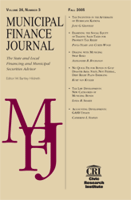Complete Issue
Author: Daniel Bergstresser.
Source: Volume 34, Number 03, Fall 2013 , pp.1-113(113)

< previous article |return to table of contents
Abstract:
This issue of the Municipal Finance Journal continues the presentation of papers delivered at the Brandeis International Business School’s 2012 Municipal Finance Conference. The first paper, “Demographic Fractionalization and the Municipal Bond Market,” by Daniel Bergstresser, Randolph Cohen, and Siddharth Shenai, examines the relationship between demographic structure—in particular the ethnic and religious diversity of local areas—and municipal borrowing costs. The paper finds evidence that localities that are more demographically diverse have higher borrowing costs. Results suggest that the more diverse counties are actually riskier, either in the sense of observed default risk or ratings downgrade risk; that the bonds issued by the more diverse localities trade slightly higher in the secondary market immediately after issuance; and that these effects are strongest among the smallest bond issues (the effect disappears once the bond issue becomes large enough). The authors conclude that this pattern of evidence suggests that some type of inefficiency is affecting borrowing costs and having a specific impact in the more diverse localities. In discussing the paper, Bart Mosley points out that the paper fits nicely into a broader literature on the limits of market efficiency, in particular with regard to the evidence that the higher borrowing costs for more diverse areas have not been associated with higher default probabilities. Mosley highlights the fact that the paper appears to demonstrate the existence of some significant inefficiencies in municipal markets. He also comments on the importance, in empirical work like this, of making sure that alternative theories have been ruled out. For example, more diverse localities may also be less affl uent, so the observed relationship may refl ect wealth rather than diversity itself. Mosley notes that the authors include a large set of “control variables” to account for these alternative stories. Andrew Ang and Richard Green, in their paper “Lowering Borrowing Costs Through CommonMuni,” present both a description of the current state of the municipal market and a specific proposal aimed at improving the way in which this market serves borrowers and investors. They propose the establishment of a nonprofit independent advisory firm— CommonMuni—to provide independent advice to issuers. They specifically mention advice regarding municipal use of derivatives, which has been a particular focus of concern recently. The authors also call for CommonMuni to collect and disseminate information about borrowing costs and to help promote standardization of issue characteristics. They point to standardization as one way of reducing trading costs and improving the liquidity of municipal issues. The conference session was moderated by Win Smith, whose discussion paper is provided here. Although Smith agrees “with much of [Ang and VI Green’s] diagnosis and endorse[s] their prescription, . . . [he recommends] that they, and any future managers of CommonMuni, take care to discern the motivations of both issuers and investors, and to recognize the pitfalls of ‘best practice’ advocacy.” Richard Ryffel provides a second review of Ang and Green’s paper and concludes that although “‘CommonMuni’ raises some interesting questions about the municipal bond market, . . . it does this without presenting overwhelming empirical evidence that arming both issuers and investors with more information would result in better practices.” Ryffel notes that “the municipal market, given its unique characteristics, may never be as efficient as other markets or as theory might suggest is possible.” Once again, we hope that the readers of MFJ will find these papers thought-provoking and useful in their areas of interest and practice.Keywords: Fractionalization, municipal bonds, borrowing cost, underwriting efficiency, CommonMuni, municipal market transparency, municipal market liquidity, derivatives, advance refundings
Affiliations:
1: Guest Editor (Brandeis Intl Business School).